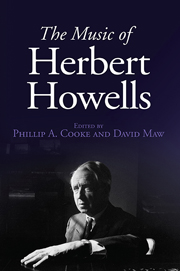Book contents
- Frontmatter
- Dedication
- Contents
- List of Illustrations
- List of Musical Examples
- List of Tables
- List of Contributors
- Foreword
- Acknowledgements
- Miscellaneous Frontmatter
- Introduction: Paradox of an Establishment Composer
- PART I Howells the Stylist
- PART II Howells the Vocal Composer
- PART III Howells the Instrumental Composer
- PART IV Howells the Modern
- PART V Howells in Mourning
- 13 In modo elegiaco: Howells and the Sarabande
- 14 On Hermeneutics in Howells: Some Th oughts on Interpreting His Cello Concerto
- 15 Musical Cenotaph: Howells's Hymnus paradisi and Sites of Mourning
- Appendix: Catalogue of the Works of Herbert Howells
- Bibliography
- Index of Works
- General Index
14 - On Hermeneutics in Howells: Some Th oughts on Interpreting His Cello Concerto
from PART V - Howells in Mourning
Published online by Cambridge University Press: 05 December 2013
- Frontmatter
- Dedication
- Contents
- List of Illustrations
- List of Musical Examples
- List of Tables
- List of Contributors
- Foreword
- Acknowledgements
- Miscellaneous Frontmatter
- Introduction: Paradox of an Establishment Composer
- PART I Howells the Stylist
- PART II Howells the Vocal Composer
- PART III Howells the Instrumental Composer
- PART IV Howells the Modern
- PART V Howells in Mourning
- 13 In modo elegiaco: Howells and the Sarabande
- 14 On Hermeneutics in Howells: Some Th oughts on Interpreting His Cello Concerto
- 15 Musical Cenotaph: Howells's Hymnus paradisi and Sites of Mourning
- Appendix: Catalogue of the Works of Herbert Howells
- Bibliography
- Index of Works
- General Index
Summary
Herbert Howells was notorious for revisiting works, revising and restructuring – from chamber works like the Third String Quartet, In Gloucestershire (HH 62, which exists in at least three versions: see Chapter 8) to the substantial reworking of the Requiem (HH 188) to form Hymnus paradisi (HH 220), it seems that Howells was rarely satisfied. However, one work stands apart in personal significance – his Cello Concerto (HH 205–7). Starting it in 1933, Howells worked on it throughout his life, even revisiting it close to his death. It was clearly an important work for him, and on more than one occasion he referred to its slow movement as his finest work. This article serves as an introduction: to contextualise it by outlining its history; to discuss elements of structure and style; and to consider our hermeneutical approach to Howells, here and in the rest of his output.
There are several compelling reasons why a hermeneutical approach to Howells should be considered, and is, arguably, overdue. This particular branch of analysis, within which the emphasis is shifted from issues of structure and technique, towards issues of meaning and context, which are ‘empathetic rather than empirically verifiable’, is perhaps the key to demonstrating why Howells the composer deserves a more widespread consideration. Through the success of Christopher Palmer's A Centenary Celebration and Paul Spicer's biography, a clearer picture of Howells the man is starting to emerge, but the next step, of linking our understanding of Howells the man and his music, is much harder.
- Type
- Chapter
- Information
- The Music of Herbert Howells , pp. 274 - 284Publisher: Boydell & BrewerPrint publication year: 2013



